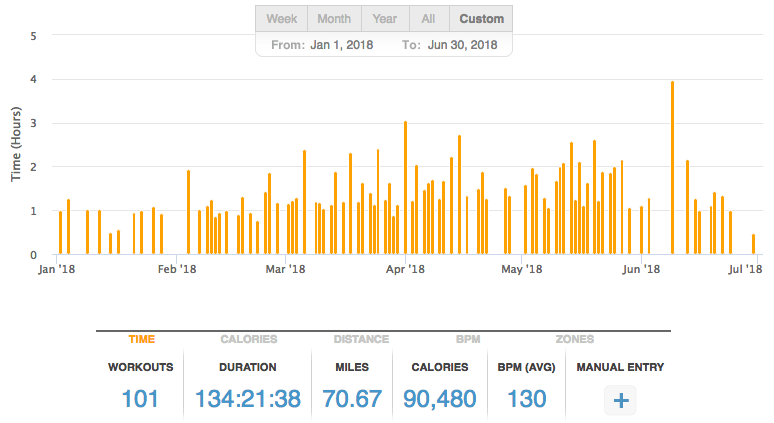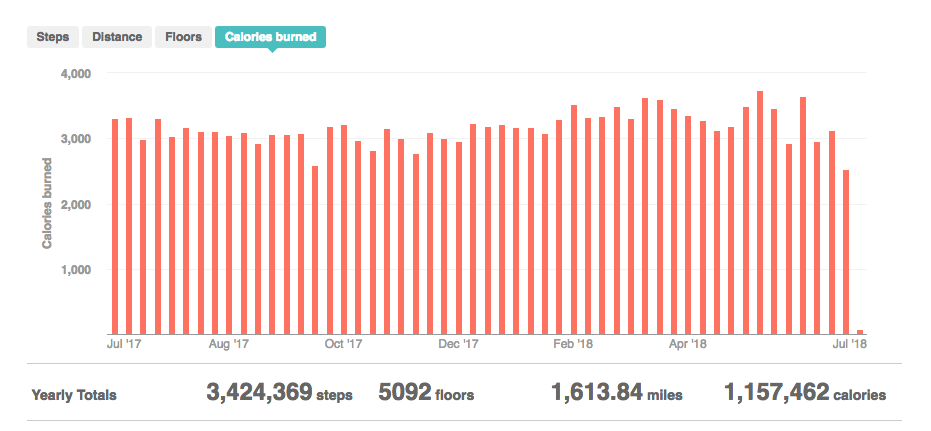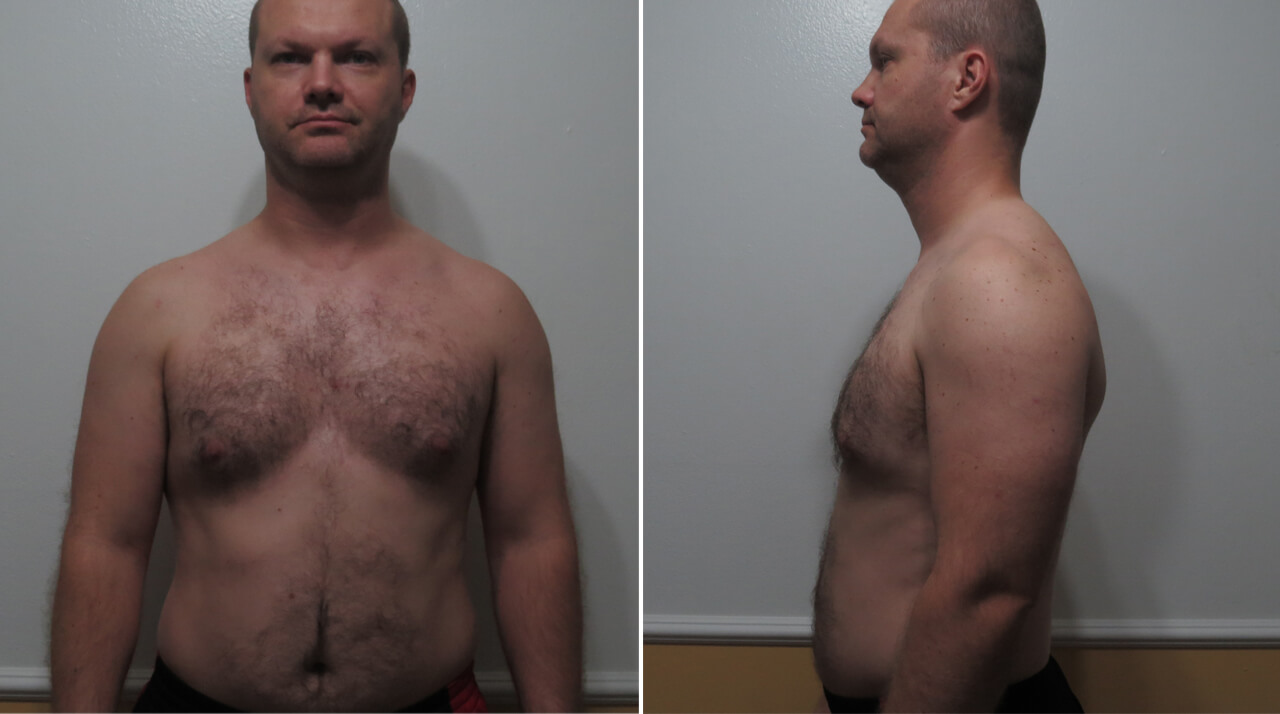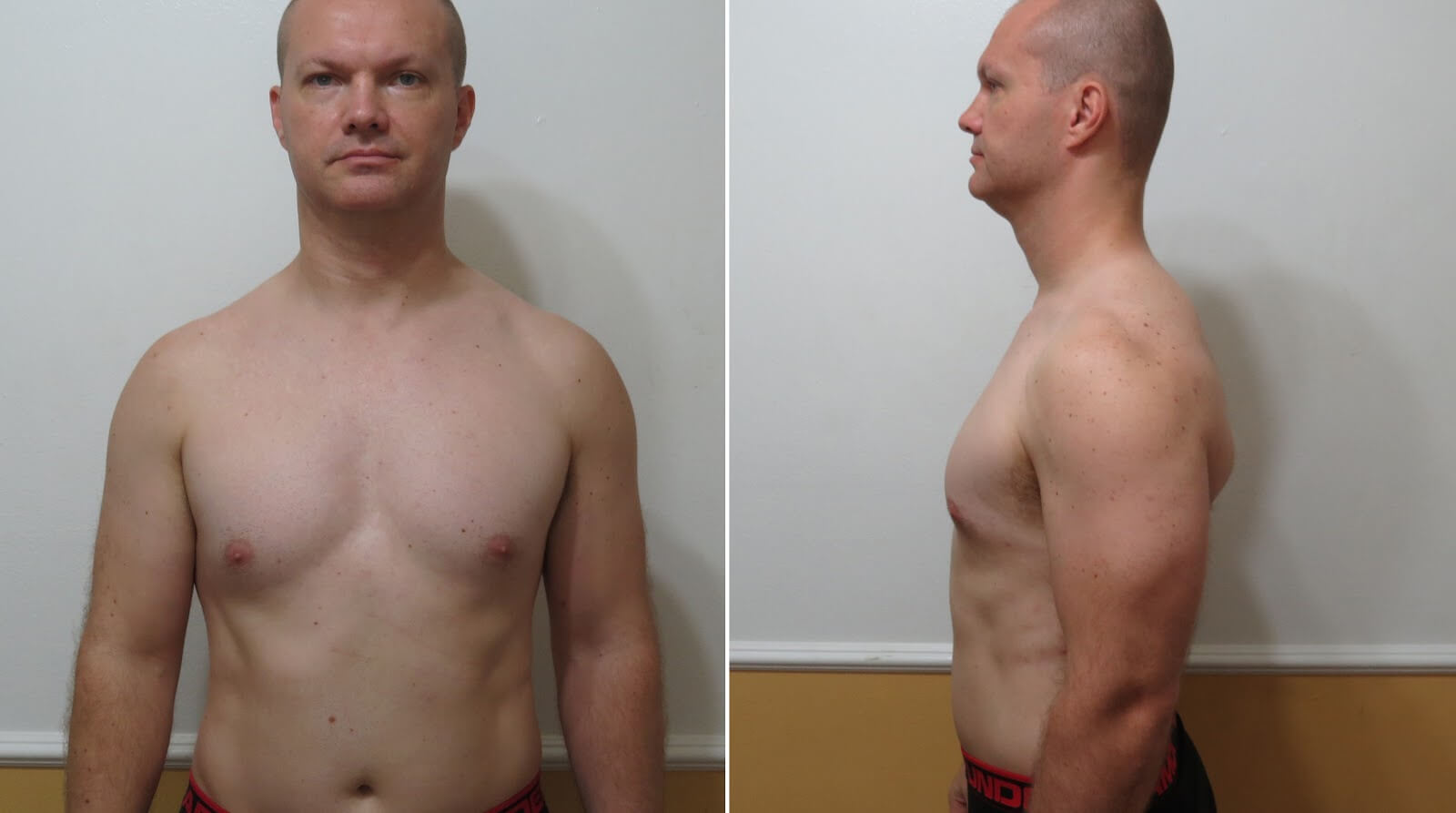“Who’s stupid idea was this anyway?”
It definitely wasn’t the first time I had asked myself this in the last six months since declaring that my #1 goal for 2018 was transforming From ‘Dad Bod’ to American Ninja Warrior.
I was asking myself this question this particular instance after having just woken up at 5am on a Saturday and driving 350 miles north to Monterey so I could pay good money to run 10 miles in the mountains, carry sandbags and buckets full of gravel up hills, army crawl under barbed wire, climb 2500+ feet of elevation gain, and wade through mud (just to name a few of the over 30 obstacles).
Here’s the catch: Three days before the race I couldn’t bend over to tie my shoes. I had strained my QL muscle (lower back) earlier that week doing kettlebell deadlifts. To add insult to injury, two weeks before that I landed awkwardly while practicing a vault in parkour class and had a deep bone bruise in my left knee…which I later discovered was also a sprained MCL.
Needless to say, I don’t know a lot of other sane people who would wake up at 5am on a Saturday after having worked a 60+ hr week, drive 700 miles in a day, and run a 10 mile Spartan Race on a bum knee who can barely tie their shoes.
But sane is boring.
Striving for a life of comfort ultimately leads to complacency which leads to boredom which leads to unhappiness which leads to self-loathing which leads to hours spent in front of screens every day to escape the drudgery of life.
Living life outside your comfort zone is where real growth and change occurs.
To quote one of my favorite ANW superstar athletes:
“Get comfortable being uncomfortable.”
– Flip Rodriguez
Having spent the majority of 2018 up until this point being very uncomfortable on a daily basis, here are six lessons I’ve learned after six months of training for American Ninja Warrior.
LESSON #1. The best time to plant a tree was twenty years ago. The next best time is today.
At 38 years old I have a lot of excuses for why becoming an American Ninja Warrior is just a stupid idea. Most of the athletes that compete on the show, even those who are my age or older, have an athletic background. Many are former gymnasts, track & field stars, pole vaulters, professional and amateur rock climbers with decades of experience, gym owners and personal trainers, or freerunners and parkour artists.
The last time I did anything truly athletic was in high school when I trained for (and earned) a black belt in martial arts. Once I hit college and then the real world I was 100% career focused. A few years ago once the weight started to pile on I took up obstacle course racing and did a few Spartan Races and Tough Mudders…but as a hobby. I was a “Weekend Warrior,” and my only objective was finishing the course and having some fun along the way. Training intensely for 10+ hours a week for a sport like American Ninja Warrior is a world I haven’t inhabited since my face was covered with acne, my voice cracked, and I was studying for my driver’s test.
There’s no question the best time to become an athlete was twenty years ago. I can’t even imagine how much easier training would be today had I chosen to continue my martial arts study, or take up gymnastics, or become a rock climber in college.
But that’s no excuse.
Rather than thinking “it’s too late,” I instead look at my circumstances from a different perspective.
In December 2017 when I decided my #1 goal for 2018 would be to train for American Ninja Warrior, I closed my eyes and jumped into my mental time machine to travel forwards 12 years. I pictured myself at fifty years old at my daughter’s high school graduation. I was (still) bald, at least 50 pounds heavier than I am now with chronic lower back pain, two bum knees, constant visits to the cardiologist for heart issues, and still battling depression and anxiety.
As I sat there watching my daughter walk across the aisle and receive her diploma, my future self thought: “I wish I hadn’t been too afraid to train for American Ninja Warrior when I was 38. My life would be so different right now.”
That single mental image was more than enough to compel me to jump into training right on January 1st because my only true fear is regret.
IN SHORT:It’s never too late to begin writing chapter 1 of your new “origin story.”
LESSON #2. If you set your goals improperly, tremendous success can end up feeling like total failure.
For the past fifteen years I’ve been completely obsessed with learning everything I can about the psychology of high performance and the habits that lead to success. One of the most important lessons I’ve learned during this journey is that achieving a goal is meaningless if you set the wrong goal.
Your goals are the foundation that your house is built upon. If you build your house on quicksand, it doesn’t matter how strong the walls or the roof is, your house will collapse. It’s imperative that you take the time to clearly define a goal properly before taking a single action towards achieving that goal.
I spent weeks painstakingly clarifying my “macro goal” in December of 2017 before taking a single moment to plan my diet, map out my training regimen, or stepping foot in a gym and doing a single pull-up. The conclusion I came to after working through the steps I teach in my Design Yourself program is that “Getting on American Ninja Warrior” is NOT going to be my goal.
Wait…what?
Bear with me for a second. Let’s assume this is the goal I set:
“I will be on season 11 of American Ninja Warrior in 2019.”
This goal depends on outside circumstances that I have no control over. I could show up to the gym every morning, lose 25 pounds, drop to 10% body fat, and become an expert at ninja obstacles over the next 12 months. To everyone but me, this would look like tremendous success.
But if I’m not chosen as one of the over 40,000 people who submit audition videos every season? I would be a total failure.
The problem with this goal is that it’s binary – there are only two possible outcomes.
Outcome 1 is I get on the show – Success.
Outcome 2 is I don’t get on the show – Failure.
I’d rather set myself up for success and build systems around a goal that is completely within my control. Simply put, as long as I put in the work consistently, I will be successful.
Therefore, here’s the macro goal I set for 2018:
“I will weigh 175 pounds and be in American Ninja Warrior shape by December 31st.”
The difference is subtle yet completely changes the systems I build that ensure I follow through and achieve my goal. This is a SMART goal.
It’s Specific.
My goal is not to “be healthy” or “lose weight” it’s to be in a very specific kind of physical shape.
It’s Measureable.
I will weigh 175 pounds. Weight is a metric that can be tracked.
It’s Actionable.
Taking concrete daily actions will lead me closer to success.
It’s Relevant.
This goal aligns with the work I do in my business. It helps raise awareness of my documentary film GO FAR. And I’m setting a good example for my children.
It’s Time-Sensitive.
I have a specific deadline of December 31st.
My goal has nothing to do whatsoever with being on the show. If I lose 25 pounds, drop five inches off my waist, shed body fat, and develop the strength and coordination to compete on ANW-level obstacles, not being chosen is immaterial. I will have succeeded come December 31st, 2018.
IN SHORT:Before you invest a tremendous amount of time, energy, and attention in achieving a difficult goal, make sure you have set the right goal first.
LESSON #3. The best way to eat an elephant is one bite at a time.
When you’ve just crossed the threshold of 200 pounds for the first time and you max out at (barely) 5 pull-ups, the thought of running one of the most difficult obstacle courses on the planet sounds downright impossible.
I already know I have to lose at least 25 pounds to even be in the same conversation as most of the other athletes on the show (I’m 5’ 11” so getting below 170 just ain’t happening). It would also be nice if I could dead hang from a bar for at least 3 minutes and be able to do a minimum of 20 pull-ups by the end of the year.
That’s great…but so what?
What the hell am I supposed to be doing this morning?
Often times people procrastinate and avoid taking action towards their goals because the result is too far away and seems like success will never come. The key to overcoming the procrastination and fear that accompany pursuing difficult goals is to break down a “macro goal” into tiny “micro goals” that seem so simple there’s no reason not to do them.
My macro goal was crystal clear on day 1, so now it was time to break that down into an action plan with very doable micro goals.
Being in “ANW shape” by December 31st requires that I develop a series of skills including: Rock climbing, Parkour, and Crossfit. And I’ll probably need to train 5-6 days per week. Over the course of the next year, assuming a few recovery weeks and family vacation time, that’s “hitting the gym” over 200 times in the next twelve months.
Um….no thank you.
Yet despite the massive overwhelm of going to the gym over 200 times this year, by the six month mark I’m over halfway there.

Workout stats courtesy of Fitdigits.com

Daily activity stats courtesy of Fitbit.com (I use the Fitbit Blaze)
I didn’t go to the gym over 100 times in the last 6 months and burn over 1.1 million calories in the last six months by focusing on the end goal, I focused on the single actions steps that would get me to show up once.
My first action step on day one was simply “Research gyms near me.”
Anyone can do that!
Once I found the places that made the most sense, the next step was not to commit to a 12 month membership, it was to “Try a free Crossfit class.”
Yup, seems simple enough.
My next action step after that was setting my gym clothes out the night before so when I woke up it was one less excuse to not show up.
Easy peasy.
Once I tried my free class, I immediately discovered that fifteen years of living in front of a keyboard have destroyed my body far worse than I anticipated. My flexibility and mobility were in the toilet.
Therefore my next micro goal had nothing to do with losing 25 pounds or doing 20 pull-ups at once. My next micro goal was learning where to put a lacrosse ball and foam roller to loosen up my hip flexors and glutes so I can get into a proper squat.
I can do that too!
Rinse. Lather. Repeat.
This mentality has led to 101 training days in 6 months, losing 14.8 pounds, and dropping 3 inches from my waist.

Jan 1st, 2018
200.7 pounds, 38” waist, 24.1% body fat (per Fitbit scale)

June 30th, 2018
185.9 pounds, 35” waist, 20.1% body fat (per Fitbit scale)
IN SHORT: No matter how difficult the goal you set for yourself, if you break it down to the simplest of actions, as long as you take action consistently, success becomes inevitable.
LESSON #4. Failure is the fastest path to success.
I wish I had been wearing a GoPro my first night in parkour class (Not familiar with parkour? Here’s a brilliant overview). The camera would have not only captured my complete ineptitude with the most basic of skills, the footage would have also demonstrated that I was a few short years away from easily being mistaken as the dad to any other person in the class…including the instructor.
There is quite possibly nowhere further outside my comfort zone on the planet then being surrounded by a bunch of seventeen-year-olds in a parkour class.
Here’s the “missing” footage from my first parkour class
Because parkour is a necessary skill I must develop in order to achieve my macro goal, I know that to have even a slim chance of being considered I must be ready to embrace failure…a lot of it. If I were afraid of failure or “looking stupid,” I simply would have stood in the back corner during open gym time and watched other people who were practicing “The Warped Wall” (the most iconic obstacle of ANW). Then when no one else was watching, I might have attempted it, but only as long as nobody was watching. After all, what if I fell? God forbid I look like an idiot.
Screw that.
During my first open gym session one of the first things I tried was the warped wall. And I failed. So I tried it again. And I failed again. I then tried another 10-15 more times before I decided to call it a night and find another obstacle I could fail at repeatedly.
Guess what I did the following week at open gym? I failed getting up the warped wall another 10+ times.
My first (failed) attempt at trying the obstacle course at ‘Ninja Beach’
A few weeks later during open gym a couple guys showed up who have been on the show and successfully run the course more than once. Sure I could’ve been super intimidated and stood off to the side as a socially awkward introvert (my default mode). But instead I walked right up to them, introduced myself, and asked if I could “join in” on the practice runs they were concocting around the gym.
When the time came to run up the warped wall I approached one of them and asked, “So what’s the trick to getting up the wall?” He asked me to run it, and of course I failed. He began to tweak my form, my steps, and my technique. And I failed a few more times.
Then I got up the wall.
Eventually on my own I would’ve gotten to the top of the wall, but being willing to publicly embrace failure (a lot) and ask questions shortened my learning curve and got me to the top infinitely faster. Now I have more time to perfect my technique and move onto other obstacles I cannot do yet.
IN SHORT: Obstacles are inevitable. You will fail. But failure is only failure if you give up and quit. Be willing to ask questions, learn from your mistakes, embrace failure publicly, and reframe it as a learning experience that gets you one step closer to success.
LESSON #5. Focus on the process, not just the results.
When undertaking any kind of athletic training, whether you have done it your whole life or you’ve chosen to dust yourself off after living behind a computer for almost twenty years, it’s SO easy to get caught up in the numbers. Especially in sports like Crossfit it’s easy to become obsessed with metrics like max reps, AMRAP’s, EMOM’s, and WOD’s…just to name a few. And the temptation is always there to compare where you are to everyone else in the class: “Hey bro, what’s your deadlift PR?” (Personal Record)
The problem with chasing after metrics whether your own or the person next to you is it makes it much harder to focus on the process, and comparing your progress to others only wastes energy you could be spending on yourself. That’s why I believe in “Running Your Own Race.”
If the only reason you’re going to the gym today is to hopefully lose twenty pounds six months from now, you will be miserable unless you embrace how every single piece of the puzzle fits together. And thinking to yourself, “Why is that person so much better than me?” only leads to self-doubt and frustration.
Working with my Crossfit trainer (one of 3 different specialists I’ve enlisted in my pursuit of ANW), we have spent weeks doing super simple exercises with tiny weights, small resistance bands, and a lot of bizarre balance exercises with no weight at all. I pictured my life being nothing but pull-ups, push-ups, squats, deadlifts, and all the other crazy hardcore exercises that come with Crossfit (and there has been some of that). Instead I’ve found myself struggling to lift a 5 pound plate with my body in some bizarre balance configuration while the guy next to me is squatting 300 pounds.
To put it simply, instead of working towards doing 20 pull-ups at once no matter what it takes, our goal is making sure I can do ONE pull-up with 100% perfect form and minimal effort before ever doing a second.
The “One Thing” I focus on every single time I train is moving my body as efficiently as possible. I don’t care about reaching a certain weight, I don’t care about how fast I do things, and I certainly don’t care about anyone around me going faster or lifting more. All I care about is my form. Once my form suffers, I know it’s time to stop.
I would rather do 5 perfect reps than 15 sloppy reps.
While this approach requires more patience, this laser-sharp focus on the details will yield much bigger long term gains. When the time comes I do have the strength, balance, and stamina to participate with the pros on a real ninja course, focusing on the tiny details (like where my hand should grab the bar, or how I should place my feet, or the angle my shoulders should be when flying from one bar to the next) will be easier because above all else, the muscle I’m training one rep at a time is my “focus muscle.”
IN SHORT: No matter the goal you are trying to achieve, stop focusing on the results you might get someday and instead focus on the process today.
LESSON #6. Life is too short to live it without Snickers ice cream pie.
When I made the proclamation that I was going to dedicate the entire year to not only losing weight and “getting back in shape” but to training intensely for ANW, I knew the possibility was there to turn this into a truly miserable experience. Just about anyone can lose 25 pounds if they’re willing to deprive themselves for a few months. In fact, the TV series The Biggest Loser is proof-positive that anyone can make radical short-term lifestyle changes and receive tremendous gains.
The problem with radical short-term lifestyle change is that it doesn’t stick, and the process sucks every single day. The vast majority of TBL participants, for example, end up gaining back all of their lost weight (with more weight on top of that1).
Choosing to train for ANW was not a 12 month decision for me that involved cutting calories and going to to gym as often as possible. Becoming an American Ninja Warrior goes much deeper.
Becoming an American Ninja Warrior is a lifestyle.
Becoming an American Ninja Warrior is an identity.
Yes I am much more careful about what I eat 6 out of 7 days per week. Yes I spend a lot of hours in the gym, and yes I’ve made a lot of personal (and financial) sacrifices to find the time and money to completely change my life over the next 12 months.
But I’ve been very clear with myself that every single change I make has to be one I’m willing to stick with for a minimum of 3-5 years. If a specific dietary choice or workout routine is one that involves deprivation and misery, I won’t do it. I don’t care about short term gains, I care about permanent lifestyle change.
I’m playing a game of chess, not a game of checkers.
Taking a Saturday off to have pizza and ice cream with my kids might mean it will take a little longer to reach my weight and body fat % goals, but I’d rather my kids remember the fun Saturday afternoons when we all had ice cream together, not the Dad who munched on celery and peanut butter at the ice cream store because “He is always training.”
I’d rather celebrate a successful Spartan Race binging at a BBQ joint with ribs, biscuits with apple-cinnamon butter, pulled pork on the side, and a giant dessert to chase it all down than not celebrate a short-term milestone because my stats might suffer for a week or two.

Yes I’m 100% dedicated to becoming an American Ninja Warrior…but life is too short to live it without Snickers ice cream pie.
IN SHORT: Radical lifestyle change is a slow process. Don’t choose behaviors that you’re not willing to stick with for a long time. Life is a game of chess, not a game of checkers.
1 https://www.businessinsider.com/new-show-biggest-loser-winners-regained-weight-big-fat-truth-2017-6
Further Reading & Listening:
From ‘Dad Bod’ to…American Ninja Warrior?
How to Develop ‘Obstacle Immunity’ | with Spartan Race founder Joe de Sena

